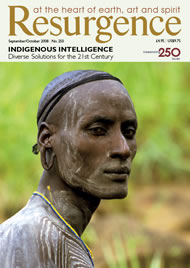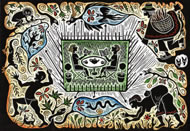I RECENTLY ASKED a class of students, representing ten nationalities from around the world, how many languages were spoken in their country. All except one – a Belgian – immediately responded by saying “one”. I suggested they research the topic and report back to the next class. The Iranian student caused the most surprise during the feedback session when he gave the figure of eighty-nine. Statistics were based on Indigenous, or endemic, languages, not including recent immigrants.
When asked how many languages are spoken in the world, people often come up with a figure of anything from 50 to 600. This is way below the accepted figure of 6,000 to 7,000. As with biodiversity, languages get thicker on the ground as you approach the equator. Unfortunately, as with biodiversity there is also an increasing extinction rate.
Tove Skutnabb-Kangas, a foremost writer on many aspects, writes that over the last 500 years “about half the known languages of the world have disappeared,” and another researcher, Michael Krauss, estimates that 90% of today’s languages might be extinct in 100 years’ time, leaving about 600. Some researchers make a lower estimate. This is a stark picture: languages are dying out, but awareness of this phenomenon is little discussed outside academic circles. Does it matter?
The answers to this question are complex and, in today’s world, become intermeshed with the political development of society, particularly since the rise of the nation-state; it is no accident that there are fewer languages spoken today in Europe, the place where the nation-state originated, than for example in just one African country: Nigeria.
Most European nations have one language as their official language, and speakers of ‘minority’ languages have been marginalised – perhaps belatedly recognised within the EU, but largely dying out. The US is the best example of a nation’s language – English – smothering all other languages.
In 1996 there was a conference at the University of California, Berkeley, at which Luisa Maffi, Director of Terralingua, said that there are “remarkable overlaps between global mappings of the world’s areas of biological megadiversity and areas of high linguistic diversity” just as there is “a high correlation between low cultural diversity and low biodiversity”.
Taking this a stage further, David Harmon, Secretary of Terralingua, looked at endemism in language and in higher vertebrates. Endemism refers to something that is peculiar to a particular region. Harmon then looked at the twenty-five countries that had the most languages, and the twenty-five countries that had the most higher vertebrates; he found that sixteen countries (64%) were on both lists:
• extensive countries with highly varied terrain, climate and ecosystems, such as Mexico, Brazil and China;
• island countries such as Papua New Guinea, the Philippines and the Solomon Islands; and
• tropical countries such as Cameroon, the Democratic Republic of the Congo and Tanzania.
He adds ‘urbanisation’ to factors promoting low diversity.
Harmon also found a high correlation between languages and flowering plants: a region would either have many of both, or few of both. Skutnabb-Kangas discovered that where there are many languages there are also many butterflies, and she lays out the case for the relationship between linguistic and cultural diversity and biodiversity being not only correlational but also causal – perhaps not directly so, but the implication is that linguistic and cultural diversity may be decisive mediating variables in sustaining biodiversity itself, and vice versa. For example, more than 40,000 edible plants were known to the Aboriginal inhabitants of South Australia; very few of these are now used by the European immigrants, who have neither lexicalised them nor used them. This leads to their disappearance and perhaps elimination as they are seen as ‘weeds’.
Skutnabb-Kangas gives a long account of how the ‘human-environment coevolution’ works in the Sámi language and culture of northern Finland and Norway. She states that the prerequisite for making a living from Nature for the hunter is to have an intimate knowledge of the landscape, and in order for this to be passed on to future generations the language has to have exact expressions and precise terms for concepts which are important to support life. Similarly a large vocabulary makes it possible to describe and remember landscapes and places in rivers and lakes when conversing about hunting and fishing. Colonisation is described as one of the abrupt ways in which such knowledge can disappear.
GENERALLY SPEAKING, IT is noticeable how much in common there is between biological and linguistic diversity: the number of varieties are concentrated in similar places, and more ominously the activities of a few species or languages can have negative consequences. Just as, for example, the cane toad introduced into Australia is inexorably spreading and wiping out local fauna, and monocultures of Eurasian origin such as wheat, barley and cattle are replacing a profusion of local species, so languages such as English, Spanish and Chinese are expanding at the expense of local dialects and languages. The disappearance of hundreds of species of fish, birds and other forms of life along with their names and related knowledge of their habitat and behaviour represents a huge loss to science at precisely the time when we need most urgently to manage local ecosystems more effectively.
Harmon writes most poignantly of all about a future with less diversity: “It is perfectly conceivable that life on Earth could have evolved so as to present us with conditions much closer to those that, say, a prisoner feels in solitary confinement. Rather than a world supplied with millions of species, thousands of languages and other cultural distinctions, and a tremendously varied landscape, we might have drawn one far more barren. We could have been born into a world populated by starlings and weeds, where every person spoke and dressed and ate and behaved more or less the same, where every field and town looked pretty much like any other… But we were lucky. We got the world that we have. The one we have inherited is truly, even yet, a world of difference. At its heart is a paradox: human beings need sameness, but being human means we first need genuinely rich stores of biocultural diversity to distil it from. If we continue to act in ways that destroy diversity, life of a sort will go on, but our aliveness – our uniquely human feeling of what life is supposed to be about – will have become extinct.”
Bilingualism in International Schools.








